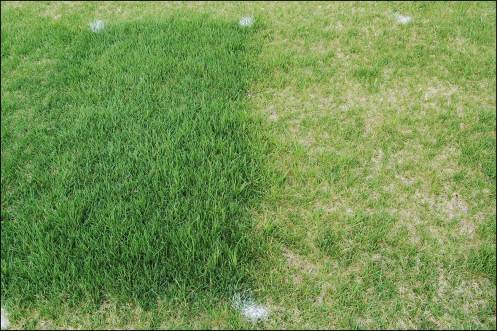After 9 years with 768 blog postings that had 2,105,688 views from 1,385,988 visitors to this tipsfromashton blog site… I am going to slow down from this retirement gig! I am not going to stop altogether as I will likely do an occasional blog posting and will happily answer your questions. (During the past 9 years I have answered 1,634 of your questions/comments.)
The thing that I have enjoyed most about this retirement gig that capped my Scotts Miracle-Gro Company career that began 46 years ago in 1973, is the opportunity to pass along my lawn and garden tips. Hopefully along the way this has helped to make your thumb just a little bit greener.
My wife Rita and I will still be enjoying our Georgia gardening activities with our grandkids as we continue swapping advice with our friends!

The shifting fall weather means fire ant mounds are showing up around these parts. They wreak havoc on your lawn, and make it next to impossible to feel safe and enjoy your outdoor space with friends and family.
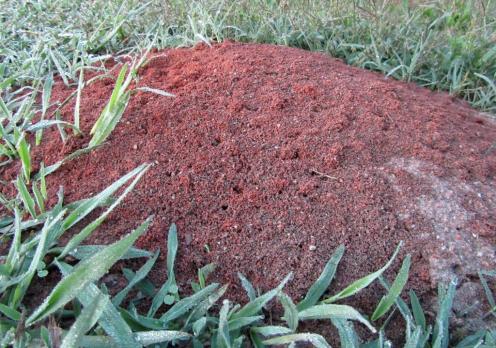
Fire ant mound in red Georgia clay soil
Now there are two ways to kill the fire ants you see and control the ones you don’t see.
The first one is a mound bait to kill fire ant queens and mounds. Just sprinkle the bait in a 4-foot diameter around the mound. Fire ants think it’s food and bring it back to the mound for feeding. It’s a deep-reaching solution that requires no watering. Ortho Fire Ant Killer Mound Bait kills both visible and hidden mounds and prevents mound relocation.
The second method is a 2-Step whole lawn treatment to not only rid your lawn area but to discourage neighborhood ants from invading your lawn.
Step 1 – Kill the Mound: Treat mounds you see with Ortho Orthene Fire Ant Killer . This product is designed to kill the queen and destroy the mound. Do not disturb the mound prior to treating. Sprinkle a tablespoon of product over and around each mound and do not water. Over the next several days the ants and queen in the mound will be killed.
Step 2 – Protect the Ground: Treating only the mounds you see is not enough to completely get rid of fire ants. That is because not all fire ant mounds are easily seen. Colonies may remain active underground, hidden from sight. Additionally, new queens can fly in to establish colonies or foraging fire ants may enter the yard to look for food. Use a lawn spreader to put down Ortho MAX Fire Ant Killer Broadcast Granules to protect your lawn by killing foraging fire ants and controlling new fire ant mounds from forming for up to six months. Water your lawn after spreading the granules. If you want to put a Weed & Feed on your St. Augustinegrass and protect against fire ants at the same time you can use Scotts Turf Builder Southern Triple Action, This is an innovative 3 in 1 formula that prevents and kills fire ants for up to 6 months, kills stubborn weeds like dollarweed and clover, and feeds and strengthens your lawn.
My first experience spreading lawn food was with a drop spreader, the type you need to overlap the wheel tracks to make sure you do not miss areas of your lawn. I did pretty good until I was running low on granules and started to increase the distance between my back and forth trips with the spreader. In a week or so it was clear what I had done when everyone could see the stripes of dark green fed grass next to the light green unfed grass.

Old fashioned drop lawn spreader missed all the light green lawn areas.
Recently my neighbor sent me pictures of dead spots in his lawn after he made the mistake of spreading lawn food by hand rather than using a spreader.
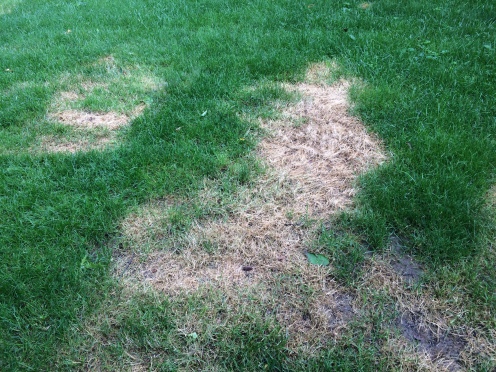
Lawn damaged by spreading lawn food by hand rather than using a spreader.
Now for the good news: Scotts lawn spreaders are not only easier to use now, they are faster allowing you to feed the typical lawn in less time than it takes to mow. This short video shows you how to use a broadcast spreader.
Want to look like you know what you are doing when it comes to lawn care AND not dip too far into your wallet to pull it off? You ask any turf expert how they would spend their first lawn care dollar and they will tell you the same thing I am about to tell you. (And, I know you will be thanking me later for this very important bit of lawn advice.) You get the most bang for your buck and your efforts by giving your lawn two feedings in fall. (If you have a southern grass like Zoysia, Bermuda, Bahia, or St. Augustine your lawn likely only needs a single September feeding. If you have already fed your Centipede two or three times this year, you can skip any further feeding until next spring.)

Lawns that are not allowed to starve in fall give you thicker grass now and next spring
Here’s what you need to do for Bluegrass, Fescue and Perennial Ryegrass lawns: You spread your first fall feeding in September. That’ll give your lawn a chance to recover from any summer lawn damage. Now you might not see much improvement at first, but don’t get discouraged. A lot of the improvement from an early fall feeding is happening underground, as new grass roots develop and spread. In fact, the underground root development will go on until the ground freezes, long after the first frost.
Within a few weeks, the lawn will start looking healthier. But the real improvement comes with the second feeding about 6 weeks after the first in late fall. This one helps to lock in what you’ve just gained, and carry it into the spring. What’ll happen is that your lawn’s increased root mass will absorb and store the nutrients from the fertilizer. Once spring arrives, your lawn will quickly tap into these nutrients, for a beautiful burst of green. In fact, a lawn fed twice in the fall will be the first to green up in the spring!
And I know I’ve said this before, but I can’t emphasize it enough. When it comes to lawn food, spend the few extra bucks for a really good one. There are big differences in how lawn foods work, and with a product like Scotts Turf Builder or Scotts Turf Builder WinterGuard, you’ll see a big improvement in how your lawn looks! You can count on it!
Oh by the way, one of these feeding can contain a weed control like you find in Scotts Turf Builder WinterGuard Fall Weed and Feed. This is a great time of year to kill clover, ground ivy (Creeping Charlie), dandelions and other weeds. Just make sure you apply to moist foliage on a day when rain is not expected. Application to a dew covered lawn in early morning really works well. And, don’t forget, any newly seeded areas should not be treated with weed control until after your new grass has been mowed 4 times.
It’s like part two of some bad movie you didn’t want to see the first time around. It’s “The Return of the Evil Lawn Weeds!” starring dandelions, chickweed, clover, ground ivy and a bunch of other weeds you thought you did away with last spring. What are they doing in your lawn this fall and more importantly, what can you do about them?

Fall is a great time of year to kill Ground Ivy (also known as Creeping Charlie).
The weeds are out there because the wetter, cooler fall weather is the ideal time for them to grow. The good news is you can terminate them the same time you feed your lawn this fall with Scotts Turf Builder WinterGuard Weed & Feed, or if you only have a few, you can spot spray them with Ortho Weed-B-Gon MAX plus Crabgrass Killer OR Roundup For Lawns after you have fed your lawn with Turf Builder WinterGuard (the lawn food without the weed control in it).
Why is this a good time? Because they’re growing right now, weeds really soak up what you put down right down to the root, so they’re completely destroyed. Plus, getting them now, before they spread, will dramatically reduce the number of weeds in your lawn next spring.
Put down Turf Builder WinterGuard with Plus 2 on moist foliage on a day when rain is not expected and do not water the day you put it down.
If you have St. Augustinegrass, use Scotts Bonus S Weed & Feed to control your weeds. Water after spreading this product.
One last bit of advice: If you put down grass seed this fall, you should not put down weed controls is those areas you seeded until after your new grass has been mowed 4 times.
The roots of your lawn function like an old fashioned root cellar. And now is the time to fill them up with food for the winter.
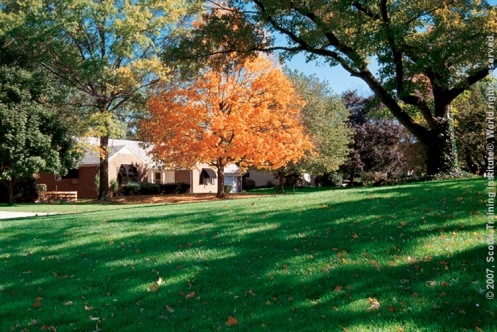
Feeding your lawn in fall will help create stronger roots.
Feeding your lawn twice this fall is the perfect way to pack nourishment into your lawn’s roots, and keep it there over the winter. So next spring, when your grass is at its hungriest, it’ll already have its own built-in storehouse of food. And you’ll have a green lawn longer this fall and the first green lawn on the block come spring.
Put down Scotts Turf Builder as soon as you can and then feed again in about 6 weeks with Scotts Turf Builder WinterGuard. Your neighbors will all think you are the lawn care guru on your block.
(Note: For southern grasses, like Zoysia and Bermudagrass, one feeding is all you need this fall. For Centipedegrass, you can skip the fall feeding.)
This time of year Ants, Spiders, Scorpions, Roaches, etc. etc. etc. are coming a knocking. The nights are getting cooler and all those home invaders are looking for somewhere warm… our house. I protect our home from a long list of invaders by spraying a barrier around our foundation. It is easy, fast and saves lots of money compared to hiring someone to do this job I can do myself. I put down Ortho Home Defense MAX Outdoor Perimeter Insect Killer. I like this product not only because it works great, I also like that it does not stain and there is no bad odor. You can put down your protective barrier as dry granules (click here for info) or as a spray (click here for info). There is also a concentrate available for large areas (click here for info).
This is a reminder for all of you who have asked me about killing Poa Annua (see photo) back in spring. Now is the time to put down a preventer before it has a chance to germinate this fall.

This is an early spring picture of the annual grass Poa Annua in a Bermudagrass lawn. Notice the light colored seeds.
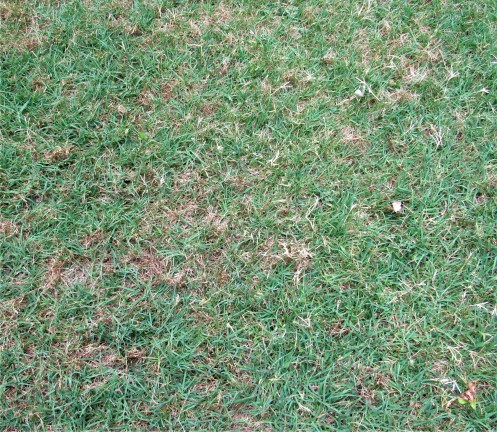
In early Summer Poa Annua starts to die, however the seeds will germinate in Fall.
Lawn weeds like Poa Annua (Annual Bluegrass), Common Chickweed, and Henbit are “Winter Annuals”. This means they germinate in fall, thrive in spring and then die during summer, but not before scattering seed so the cycle can start all over again in fall. (“Summer Annuals”, like Crabgrass, Foxtail and Barnyardgrass, have the opposite cycle of germinating in spring, thriving in summer and dying just prior to winter, but not before scattering seed so the cycle can start all over again in spring.)
If you vowed last spring that you wanted to stop these winter annual weeds from invading your lawn, you need to pick up a bag Scotts WeedEX with Halts or Scotts Turf Builder with Halts (if you want to feed at the same time) so you can treat your lawn now. (One of these Halts products is the correct product to use even though it says to apply in spring to prevent crabgrass. Read further in the directions and you will see info about applying this time of year to prevent Poa Annua and other winter weeds) Be sure to water after application.
Caution: If you are planning to plant grass seed this fall, you should not spread weed prevention in those areas as it will keep your good grass seed from germinating.


